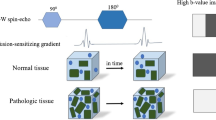Abstract
Spinal cord injury (SCI) is a severe disorder of the CNS leading to tissue damage and disability. Because it is critical to understand the pathological processes, it is important to find efficient ways to diagnose the severity of injured spinal cord tracts in situ from beginning up to a certain level of recovery following therapeutic interventions. In the current study, we set-up the criteria for diffusion tensor imaging (DTI) in order to capture changes of nerve fibre tracts in rat spinal cord compression injury. We tested four DTI parameters, such as fractional anisotropy, mean diffusivity, axial diffusivity and radial diffusivity at the lesion site, in time course of 7 weeks. Afterwards, we compared DTI data with histological results and locomotor outcomes to examine their consistency and capability of reflecting the lesion development in time. Our data confirm that DTI is a valuable in vivo imaging tool capable to distinguish damaged white matter tracts after mild SCI in rat. Fractional anisotropy showed decreased values for injury site, while the mean diffusivity had higher values, with increased both axial and radial diffusivity in comparison to control subjects. Thus, the combination of DTI parameters can reflect the severity of lesion in time and may correlate with histological evaluation of spared tissue, but not with locomotor recovery following mild injury associated with spontaneous recovery.






Similar content being viewed by others
Abbreviations
- AD:
-
Axial diffusivity
- BDA:
-
Biotinylated dextran amine
- CST:
-
Corticospinal tract
- DTI:
-
Diffusion tensor imaging
- FA:
-
Fractional anisotropy
- MD:
-
Mean diffusivity
- MRI:
-
Magnetic resonance imaging
- RD:
-
Radial diffusivity
- RT:
-
Rubrospinal tract
- SCI:
-
Spinal cord injury
- WM:
-
White matter
References
Freund P, Curt A, Friston K, Thompson A (2013) Tracking changes following spinal cord injury. Neurosci 19:116–128. https://doi.org/10.1177/1073858412449192
Steeves JD, Lammertse D, Curt A et al (2007) Guidelines for the conduct of clinical trials for spinal cord injury (SCI) as developed by the ICCP panel: clinical trial outcome measures. Spinal Cord 45:206–221. https://doi.org/10.1038/sj.sc.3102008
Fawcett JW (2009) Recovery from spinal cord injury: regeneration, plasticity and rehabilitation. Brain 132:1417–1418. https://doi.org/10.1093/brain/awp121
Cizkova D, Nagyova M, Slovinska L et al (2009) Response of ependymal progenitors to spinal cord injury or enhanced physical activity in adult rat. Cell Mol Neurobiol 29:999–1013. https://doi.org/10.1007/s10571-009-9387-1
Gill ML, Grahn PJ, Calvert JS et al (2018) Neuromodulation of lumbosacral spinal networks enables independent stepping after complete paraplegia. Nat Med 24:1677. https://doi.org/10.1038/s41591-018-0175-7
Han X, Lv G, Wu H et al (2012) Biotinylated dextran amine anterograde tracing of the canine corticospinal tract. Neural Regen Res 7:805–809. https://doi.org/10.3969/j.issn.1673-5374.2012.11.001
Grulova I, Slovinska L, Blaško J et al (2015) Delivery of alginate scaffold releasing two trophic factors for spinal cord injury repair. Sci Rep. https://doi.org/10.1038/srep13702
Douglas DB, Iv M, Douglas PK et al (2015) Diffusion tensor imaging of TBI: potentials and challenges. Top Magn Reson Imaging TMRI 24:241–251. https://doi.org/10.1097/RMR.0000000000000062
Zhao C, Rao J-S, Pei X-J et al (2018) Diffusion tensor imaging of spinal cord parenchyma lesion in rat with chronic spinal cord injury. Magn Reson Imaging 47:25–32. https://doi.org/10.1016/j.mri.2017.11.009
Ellingson BM, Kurpad SN, Schmit BD (2008) Ex vivo diffusion tensor imaging and quantitative tractography of the rat spinal cord during long-term recovery from moderate spinal contusion. J Magn Reson Imaging 28:1068–1079. https://doi.org/10.1002/jmri.21578
Vanický I, Urdzíková L, Saganová K et al (2001) A simple and reproducible model of spinal cord injury induced by epidural balloon inflation in the rat. J Neurotrauma 18:1399–1407. https://doi.org/10.1089/08977150152725687
Yeh F-C, Verstynen TD, Wang Y et al (2013) Deterministic diffusion fiber tracking improved by quantitative anisotropy. PLoS ONE 8:e80713. https://doi.org/10.1371/journal.pone.0080713
Basso DM, Beattie MS, Bresnahan JC (1995) A sensitive and reliable locomotor rating scale for open field testing in rats. J Neurotrauma 12:1–21. https://doi.org/10.1089/neu.1995.12.1
Schindelin J, Arganda-Carreras I, Frise E et al (2012) Fiji: an open-source platform for biological-image analysis. Nat Methods 9:676–682. https://doi.org/10.1038/nmeth.2019
Chang Y, Jung T-D, Yoo DS, Hyun JK (2010) Diffusion tensor imaging and fiber tractography of patients with cervical spinal cord injury. J Neurotrauma 27:2033–2040. https://doi.org/10.1089/neu.2009.1265
Hale AT, Alvarado A, Bey AK et al (2017) X-ray vs. CT in identifying significant C-spine injuries in the pediatric population. Childs Nerv Syst ChNS Off J Int Soc Pediatr Neurosurg 33:1977–1983. https://doi.org/10.1007/s00381-017-3448-4
Vargas MI, Delattre BMA, Boto J et al (2018) Advanced magnetic resonance imaging (MRI) techniques of the spine and spinal cord in children and adults. Insights Imaging 9:549–557. https://doi.org/10.1007/s13244-018-0626-1
Devaux S, Cizkova D, Quanico J et al (2016) Proteomic analysis of the spatio-temporal based molecular kinetics of acute spinal cord injury identifies a time- and segment-specific window for effective tissue repair. Mol Cell Proteom MCP 15:2641–2670. https://doi.org/10.1074/mcp.M115.057794
Cizkova D, Le Marrec-Croq F, Franck J et al (2014) Alterations of protein composition along the rostro-caudal axis after spinal cord injury: proteomic, in vitro and in vivo analyses. Front Cell Neurosci 8:105. https://doi.org/10.3389/fncel.2014.00105
Tomko P, Farkaš D, Čížková D, Vanický I (2017) Longitudinal enlargement of the lesion after spinal cord injury in the rat: a consequence of malignant edema? Spinal Cord 55:255–263. https://doi.org/10.1038/sc.2016.133
Funding
The work was supported by research Grants ERANET-AxonRepair (DC), and APVV 15-0613 (DC), VEGA 2/0146/19, VEGA 2/0135/18, APVV 15-0029 and APVV 15-0077.
Author information
Authors and Affiliations
Contributions
ANM, DC, VC, LB, TS, IJ have written the paper. ANM, VC, LB, TS, TT, IJ have done the experiments. DC has got financial support to the project. All authors have reviewed and corrected the manuscript.
Corresponding author
Ethics declarations
Conflict of interest
The authors declare that the research was conducted in the absence of any commercial or financial relationships that could be construed as a potential conflict of interest.
Additional information
Publisher's Note
Springer Nature remains neutral with regard to jurisdictional claims in published maps and institutional affiliations.
Special Issue: In honor of Prof. Eva Sykova.
Rights and permissions
About this article
Cite this article
Murgoci, AN., Baciak, L., Cubinkova, V. et al. Diffusion Tensor Imaging: Tool for Tracking Injured Spinal Cord Fibres in Rat. Neurochem Res 45, 180–187 (2020). https://doi.org/10.1007/s11064-019-02801-9
Received:
Revised:
Accepted:
Published:
Issue Date:
DOI: https://doi.org/10.1007/s11064-019-02801-9




